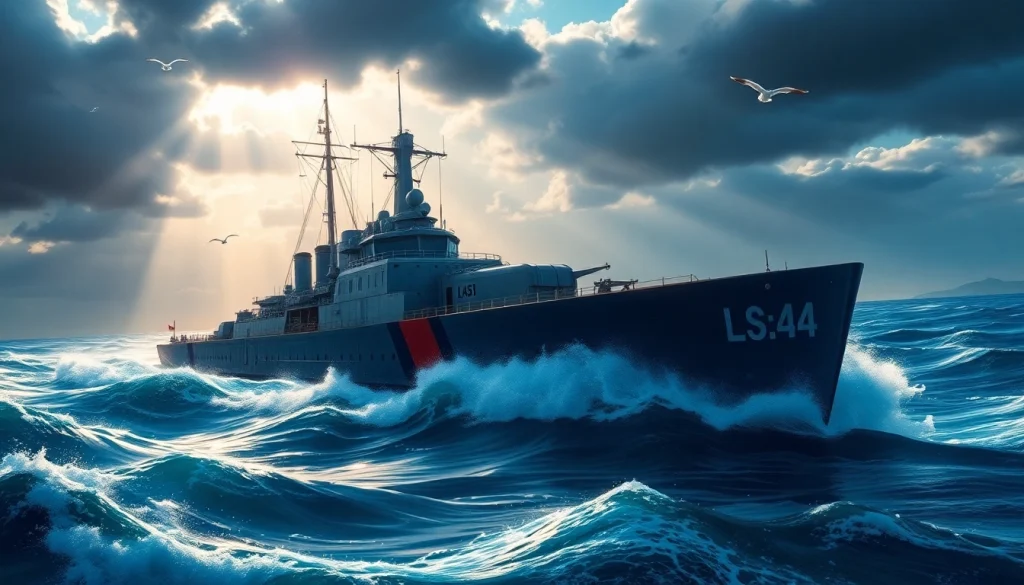
Introduction to LSM44
The journey of the USS LSM-44 is a compelling narrative that intertwines the legacy of naval innovation with the rich tapestry of military history. As a Medium Landing Ship (LSM) of the United States Navy, LSM-44 played a crucial role during its service, particularly during World War II. Design and constructed to facilitate amphibious assaults, the LSM class brought forth technological advancements that transformed naval operations. In this article, we’ll explore the significance of lsm44 in maritime history, its operational history, and the impact it made on maritime warfare.
Understanding the Significance of LSM44
The significance of LSM-44 rests not only in its capabilities as a vessel but also in the operational strategies it enabled during key moments in history. Designed for beach landings and personnel transportation, the LSM class had a distinct advantage over other naval vessels in supporting amphibious operations. The capabilities of LSM-44 allowed for the transportation of troops, equipment, and supplies directly onto hostile beaches, thereby transforming the landscape of naval warfare.
Historical Background of the USS LSM-44
Constructed by the Brown Shipbuilding Company in Houston, Texas, the USS LSM-44 was commissioned on June 21, 1944. The design of the LSM class was a response to the need for a more versatile vessel suitable for carrying out amphibious assaults. LSM-44, following in the footsteps of its predecessors, played a pivotal role in various theater operations during World War II, contributing significantly to the success of naval landings in the Pacific theater.
Key Features and Specifications
- Length: 203 feet
- Beam: 34 feet
- Draught: 7 feet
- Displacement: 800 tons
- Propulsion: Twin diesel engines, providing a speed of 14 knots
- Crew Capacity: Approximately 43 personnel
- Armament: 2x 40mm guns, 2x 20mm guns, and various machine guns for defense
These specifications helped cement LSM-44’s position as an essential player during wartime operations, allowing it to deliver troops and cargo efficiently to strategic points.
Service History of the USS LSM-44
Operations During World War II
LSM-44 saw extensive service during World War II, participating in numerous operations including the Battle of Iwo Jima and the Philippines Campaign. It was specifically tasked with the landing of troops and supplies on enemy-held shores. The ship underwent various assignments, demonstrating flexibility in accomplishing diverse missions. Notably, it was involved in providing support during amphibious assaults, where its ability to traverse shallow waters proved invaluable.
Post-War Usage and Contributions
After the conclusion of World War II, LSM-44 was reassigned for occupation duties in the Far East. Specifically, from September 15 to November 20, 1945, it participated in the Occupation Service, acting as a crucial vessel in the post-war landscape as allied forces stabilized the region. The ship continued to serve in different capacities, shifting its role to support maritime operations and training exercises within the US Navy.
Retirement and Legacy
Following its retirement in the late 1950s, LSM-44 transitioned to a reserve status and was ultimately decommissioned. Its legacy endures as one of the significant amphibious assault vessels that shaped modern naval strategies. The importance of its contributions is recognized in naval history, and it remains a point of reference for discussions about technological evolutions within the naval fleet.
Comparative Analysis with Other LSM Ships
Similar Classes and Their Roles
The LSM class of ships was part of a broader category designed specifically for landing operations known as Landing Ships, Tank (LST). While the LST class focused on larger vehicles and heavy equipment, LSM vessels, including LSM-44, were adept at loading and unloading lighter troops and supplies. This strategic differentiation allowed for a more significant engagement of troops immediately following landings.
Distinctive Features of the LSM Class
The LSM class distinguished itself through several features: its flat-bottomed hull enabled it to enter shallow waters, its ramp at the bow allowed for quick offloading, and its relatively small size provided an agility that larger vessels could not emulate. The construction, designed for easy maintenance and operation, also played a role in the class’s effectiveness in various combat situations.
How LSM44 Stands Out
Amongst its peers, LSM-44 stands out due to its commendable service record and the specific missions it undertook during critical periods of World War II. Its successful landings and operations contributed directly to mission outcomes, showcasing its effectiveness as a medium landing ship. As the Navy evolved, LSM-44’s experiences became case studies, shaping future ship designs and operational strategies.
Modern Recognitions and Tributes
Memorials and Retro Events
The memory of LSM-44 has been preserved through various memorials and events aimed at honoring those who served aboard. Reunion events for veterans and their families often include discussions surrounding the ship’s contributions, providing a platform for storytelling and shared experiences. Museums and naval institutions feature exhibits recognizing the LSM class, preserving history for future generations.
Digital Presence and Online Communities
In today’s digital landscape, online communities exist for former crew members and historians alike, focusing on preserving the legacy of LSM-44 and its sister ships. Social media platforms, forums, and dedicated websites serve as spaces to share photographs, stories, and memorabilia related to LSM-44, allowing for continued education and engagement from those interested in naval history.
How to Engage with LSM44’s Legacy
Among the best ways to engage with LSM-44’s legacy is through community participation in veteran events or by exploring online databases housing records concerning its voyages. Educational programs focusing on naval history often incorporate the USS LSM-44 into their curricula, allowing younger generations to appreciate the strategic importance of such vessels. Further, involvement in maritime museums can deepen one’s understanding of LSM-44’s contributions to naval strategies.
Conclusion: The Continuing Impact of LSM44
Lessons from History That Resonate Today
The lessons learned from the service of LSM-44 extend far beyond the realm of naval warfare. Its operations highlight the importance of adaptability and the effectiveness of strategic planning. The historical significance of LSM-44 is further amplified through the operational efficiencies it provided and its successful execution of landing missions which have influenced modern military tactics.
Fostering Educational Initiatives
Educational institutions and organizations can foster interest in naval history by incorporating discussions of ships like LSM-44 into their educational initiatives. By showcasing the impact of this vessel and the broader LSM class, they encourage students and future military leaders to appreciate historical context in military strategy and operations.
Integrating LSM44 in Cultural Narratives
Incorporating LSM-44 in cultural narratives, including literature, art, and film, serves to preserve its legacy. Celebrating such historical vessels allows future generations to recognize the sacrifices made by those who served, ensuring that the stories of LSM-44 resonate within the fabric of American maritime history.






